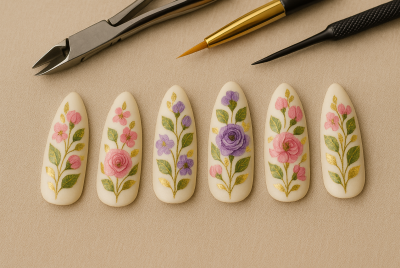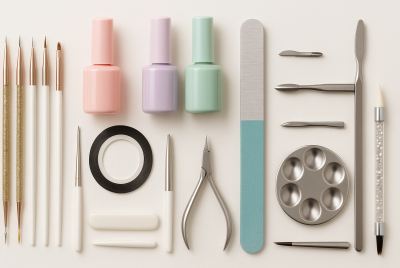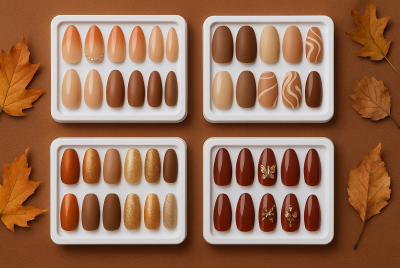How to Choose the Right Nail File for Your Nails
We may earn a commission for purchases made using our links. Please see our disclosure to learn more.
Are you looking for a proper nail file that will suit your nails? A nail file is key to maintaining healthy, well-shaped nails. However, some nail files might not really get the job done either because of the wrong grit or the wrong size. Picking the right nail file might seem pretty basic, but it makes a big difference in the look of your nails. Let’s figure this out together so you can give your nails the care they deserve.
What Is a Nail File, Really?
Alright, let’s first clarify this. The small, useful tool you use to smooth and shape the edges of your nails is called a “nail file”. Sounds easy enough, doesn’t it? However, it’s similar to choosing the appropriate toothbrush… You may get by with the wrong sort, but using the right kind? Ladies, it makes a big difference.
Why Choosing the Right Nail File Matters
You might ask whether it’s actually significant at all. Your nails are more sensitive than you may realize, and the incorrect nail file can lead to peeling, splitting, or even painful infections. It’s similar to wearing uncomfortable shoes in that you may be able to get by for a while, but trust me, eventually, it will ache. Selecting the proper file maintains your nails healthy, safe, and, to be honest, beautiful.
Types of Nail Files: Which One Is for You?
Here’s the thing: nail files come in a variety of types, each with a unique set of uses. You must first gain some knowledge about each type in order to choose the best one. I promise to make this simple and quick, so don’t worry.
1. Emery Boards: The Everyday Essential
Emery boards are those familiar cardboard-like files covered in rough grit. They’re cheap, available everywhere, and perfect when you’re in a pinch. But they do wear out quickly, and they’re not always gentle, especially on weaker nails. Think of them as the fast-food of nail files—quick, convenient, but maybe not always the healthiest choice.
2. Glass Nail Files: The Gentle Performer
Glass nail files (also known as crystal files) feel smooth and classy. They’re gentle enough for natural nails and actually help seal the edge of your nail to prevent peeling. Sure, they’re pricier than emery boards, but they’ll last forever—unless you’re clumsy like me and drop them on the floor. It’s kind of like buying a nice sweater instead of a cheap one—it’s worth the extra cost.

3. Metal Nail Files: Use with Caution
Metal nail files are sturdy, strong, and honestly, a little too tough for most people’s natural nails. They’re better suited for acrylic or artificial nails that can handle more aggressive shaping. Using them on your natural nails feels a bit like combing your hair with a fork—it might do the job, but it won’t feel great.
4. Ceramic Nail Files: The Balanced Option
Ceramic nail files sit right in the middle—they’re gentle enough for natural nails but durable like metal or glass. They’re easy to clean, don’t wear down quickly, and feel smooth and comfortable to use. If nail files had a Goldilocks version, ceramic files would be “just right.”
5. Electric Nail Files: For the Pros or the Brave
Electric nail files, those buzzing devices you see in nail salons, can be super efficient—but they’re definitely not for beginners. They’re great for shaping artificial nails fast and precisely. But if you’re new to them, one slip can leave you regretting it. So unless you’re feeling extra confident or have some experience, maybe stick to manual files for now.
Understanding Nail File Grit: What Do the Numbers Mean?
Ever noticed numbers on nail files and wondered what they’re about? If the nail file number is high, it means it’s smoother. It shows how fine or coarse the nail file is. Lower numbers are rougher. It’s a bit like sandpaper: higher numbers mean softer sanding, while lower numbers really dig in.
- 80-100 grit: Very coarse—only good for artificial nails.
- 180 grit: Medium-coarse—great for shaping natural nails.
- 240 grit: Fine—perfect for finishing natural nails.
- 400+ grit: Extra-fine—ideal for buffing your nails smooth and shiny.
Choosing a Nail File for Natural Nails
If your nails are natural, gentle is key. Choose glass or ceramic nail files, and look for grit around 240 or finer. File in one direction (not back and forth) to avoid damage. Remember, you’re not sawing through wood here—be kind to those nails!
Choosing a Nail File for Acrylic or Gel Nails
Artificial nails can handle tougher treatment. Use something coarser, around 100-180 grit. Metal or electric files can speed things up, but always be careful—you don’t want to overdo it. Think of it like sanding furniture: start strong but finish gently.
Top Nail Files for Every Nail Type
Here’s a quick list of some popular nail files for different needs. Whether you’re looking for something gentle for natural nails or a heavy-duty file for acrylics, there’s a perfect match for you:
- Mont Bleu Crystal Glass Nail File – A high-quality, ultra-smooth glass file that won’t damage or tear your natural nails. Perfect for sealing nail edges and preventing splits. Durable and easy to clean.
- Tweezerman Nail File – This gentle yet strong ceramic file is perfect for natural nails, providing a smooth finish without causing friction. Ideal for those who want a polished and healthy nail edge.
- Revlon ColorStay Emery Boards – A classic emery board that’s great for shaping natural nails in a pinch. It’s disposable, so you get a fresh, clean file every time. Comes in a convenient pack for travel.
- Sally Hansen Pro Nail File – This durable metal file is perfect for shaping acrylic or gel nails with ease. Its tough grit ensures that you can get the job done quickly and effectively.
- Makartt Nail Drill Machine – A powerful electric nail file that makes acrylic and gel nail shaping a breeze. Great for detailed work, this tool allows you to work quickly and efficiently, especially for those with busy schedules.
- Deborah Lippmann Nail Buffer File – This versatile buffing block smooths the nail surface and adds a natural shine without the need for polish. It’s an essential tool for those who want a glossy finish and healthy nails.
These products will help you maintain your nails in the best shape, whether you’re doing a simple manicure at home or taking care of acrylics.
What’s the Best Nail File for Brittle or Thin Nails?
Got thin, fragile nails? You definitely need to treat them gently. Stick to glass or ceramic files with finer grit (240 or higher). Imagine you’re handling fine china—you wouldn’t scrub it with steel wool, would you?
How to File Your Nails the Right Way
Believe it or not, there’s a right and wrong way to file nails. Start at the outer edge and move toward the middle, filing in one direction. Your nails will become weaker if you saw back and forth. It’s kind of like slicing tomatoes—you go smoothly, one direction, for clean cuts.
Which Nail File Shape Is Best?
Straight, curved, banana-shaped…why so many shapes? Straight nail files offer precision, great for neat shapes. Curved or banana-shaped files feel comfy and follow your nail shape naturally, making filing less tiring. It’s like choosing between a firm chair or a comfy sofa—they both work, but one feels better
Nail File Hygiene: Don’t Skip This
Let’s talk hygiene (briefly, I promise). Dirty nail files carry bacteria and fungi—not fun. Use soap and water to clean your ceramic or glass files on a regular basis. Emery boards don’t clean up well, so once they look worn out, toss them and get a new one. It’s like your toothbrush—you wouldn’t keep using it forever, right?
Nail Care and Health Risks: A Scientific Perspective
Scientific reviews have highlighted the potential health hazards associated with nail products and salon practices. A comprehensive review published in MDPI discusses the safety and efficacy of common nail products, pointing out possible allergic reactions and respiratory issues that salon workers might face due to chemical exposure. This aligns with the findings from OSHA, which outline the chemical hazards in nail salons, emphasizing the risks of respiratory problems and skin conditions from exposure to certain chemicals.
How Often Should You Replace Your Nail File?
Replace your nail file when it gets dull or grimy. Emery boards last a few weeks at best, while glass or ceramic files can last years with proper care. A dull file is as helpful as a dull pencil—it just doesn’t get the job done well.
Travel-Friendly Nail File Options
Always breaking a nail when you’re out? Same. Glass files often come in travel cases, keeping them safe and clean in your bag. Emery boards come in mini versions too—perfect for emergencies. Pop one in your purse, because nails have the worst timing.
Can One Nail File Do It All?
One file can’t really handle everything. Ideally, you’ll want a shaping file (medium grit), a smoothing file (fine grit), and maybe even a buffing file or block for shine. It’s like having different knives in the kitchen—you can cut most things with one knife, but sometimes you just need variety.

DIY vs. Professional Nail Files
Sure, salon-grade nail files last longer and feel nice to use. But if you’re careful, everyday home nail files can work just fine too. Think of it like cooking at home versus eating out—both are good, but sometimes it’s nice to treat yourself.
The Nail File That Matches Your Lifestyle
Are you busy and always on-the-go, or do you love a good self-care session at home? Choose a file that matches your lifestyle. Glass files are quick, clean, and easy. Ceramic files feel luxurious. Your choice should feel natural, like picking out your favorite pair of shoes.
Final Thoughts
Choosing the right nail file doesn’t have to be tricky. When you pick the one suited to your nails, filing becomes easier, healthier, and even enjoyable. So next time you’re in the nail aisle, you’ll know exactly what to reach for.
FAQs
1. Can I use the same nail file for fingers and toes?
You can, but it’s cleaner to use separate files. Toenails are thicker and sometimes carry more bacteria.
2. Should you opt for a glass nail file over an emery board?
For natural nails, yes! They’re gentler, last longer, and are definitely worth the upgrade.
3. How do I clean a nail file?
Glass and ceramic files can be washed easily with soap and warm water. Emery boards should be replaced when they get worn.
4. Can nail files go in carry-on luggage?
Absolutely! Most nail files, including glass files, are totally safe to travel with.
5. Is buffing my nails the same as filing?
Not quite—filing shapes the edge of your nail, while buffing smooths and polishes the surface. Use different tools for each task.




